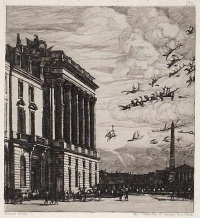Printmaking
From The Art and Popular Culture Encyclopedia
.jpg)

|
Related e |
|
Featured: |
Printmaking is the process of creating artworks by printing, normally on paper, but also on fabric, wood, metal, and other surfaces. "Traditional printmaking" normally covers only the process of creating prints using a hand processed technique, rather than a photographic reproduction of a visual artwork which would be printed using an electronic machine (a printer); however, there is some cross-over between traditional and digital printmaking, including risograph. Except in the case of monotyping, all printmaking processes have the capacity to produce identical multiples of the same artwork, which is called a print. Each print produced is considered an "original" work of art, and is correctly referred to as an "impression", not a "copy" (that means a different print copying the first, common in early printmaking). However, impressions can vary considerably, whether intentionally or not. Master printmakers are technicians who are capable of printing identical "impressions" by hand. Historically, many printed images were created as a preparatory study, such as a drawing. A print that copies another work of art, especially a painting, is known as a "reproductive print".
Prints are created by transferring ink from a matrix to a sheet of paper or other material, by a variety of techniques. Common types of matrices include: metal etching plates, usually copper or zinc, or polymer plates and other thicker plastic sheets for engraving or etching; stone, aluminum, or polymer for lithography; blocks of wood for woodcuts and wood engravings; and linoleum for linocuts. Screens made of silk or synthetic fabrics are used for the screen printing process. Other types of matrix substrates and related processes are discussed below.
Multiple impressions printed from the same matrix form an edition. Since the late 19th century, artists have generally signed individual impressions from an edition and often number the impressions to form a limited edition; the matrix is then destroyed so that no more prints can be produced. Prints may also be printed in book form, such as illustrated books or artist's books.
Contents |
Techniques
Overview
Printmaking techniques are generally divided into the following basic categories:
- Relief, where ink is applied to the original surface of the matrix, while carved or displaced grooves are absent of ink. Relief techniques include woodcut or woodblock, wood engraving, linocut and metalcut.
- Intaglio, where ink is forced into grooves or cavities in the surface of the matrix. Intaglio techniques include collagraphy, engraving, etching, mezzotint, aquatint.
- Planographic, where the matrix retains its original surface, but is specially prepared and/or inked to allow for the transfer of the image. Planographic techniques include lithography, monotyping, and digital techniques.
- Stencil, where ink or paint is pressed through a prepared screen, including screen printing, risograph, and pochoir.
A type of printmaking outside of this group is viscosity printing. Contemporary printmaking may include digital printing, photographic mediums, or a combination of digital, photographic, and traditional processes.
Many of these techniques can also be combined, especially within the same family. For example, Rembrandt's prints are usually referred to as "etchings" for convenience, but very often include work in engraving and drypoint as well, and sometimes have no etching at all.
Canonical
- Odilon Redon
- William Blake
- Albrecht Dürer
- Hendrick Goltzius
- William Hogarth
- Martin Schöngauer
- Gustave Doré
- Roland Topor
- Jacques Gautier d'Agoty
- Fornasetti
- Jacques Callot
- José Guadalupe Posada
- Charles Meryon
Bibliography
- Quatre siècles de Surréalisme (1973) by Pierre Belfond
See also
- Artist's proof
- Edition
- Graphic design
- Line engraving
- Old master print
- Print culture
- Shin hanga
- Sosaku hanga
- Ukiyo-e
- List of Printmakers

_-_Hendrick_Goltzius.jpg)



